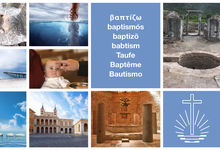The sacraments (49): Between water and Spirit
Is Holy Sealing a heritage of the Catholic Apostolic Church? The term as such perhaps, but not necessarily what we associate with it. Here is some more on the ins and outs in the history of the New Apostolic Church.

By 1951 at the latest, there were worlds between them: sealing as it was understood by the Catholic Apostolic Church on the one hand, and the New Apostolic understanding on the other. Everything that was previously attributed to baptism was now considered to be an effect of sealing: the receiving of the Holy Spirit, the complete rebirth out of water and Spirit, childhood in God, and even the incorporation into the body of Christ, or rather into the church of Christ.
The provisional sacrament had developed into the identity-building main sacrament, administered not only to adults, but also to children. And this was not an invention of the era of Chief Apostle Bischoff. It went back to the early days of the denomination that would one day be called New Apostolic Church.
The other sealing
In July 1886, the three German Apostles Menkhoff, Krebs, and Niemeyer wrote to the last still living English Apostle, Francis Valentine Woodhouse, advocating a kind of reunification. Differences were apparent already then: “Sealing aims to achieve something different and greater” than that of confirming baptism. The receiving of the Holy Spirit and being a member of the body of Christ, the congregation of the Lord, are mentioned.
The three Apostles referred to something that Apostle Schwarz had already stated or practised one or two decades earlier. He had formulated it in his book Buch für unsere Zeit, published in 1872, and practised it from the late 1860s onward by sealing children. It took decades, however, before these guidelines came to be the official teaching. This only started to change in the 1930s.
The stronger baptism
Through baptism believers become children of God. And with this sacrament, the rebirth out of water and the Spirit is completed. This is what the various publications taught, from an epistle on baptism published in 1890, to the Articles of Faith in a small textbook called Hülfsbüchlein (1908), and right up to the history book Alte und Neue Wege (“Old and New Ways”) from 1912.
From 1919 onwards, however, things started to sound different in the circulars addressed to the ministers in the Apostle district of Frankfurt, namely as in the time before Chief Apostle Niehaus: there it was sealing that completed the rebirth and conferred the childhood in God. In 1930, the author of the letter, Johann Gottfried Bischoff, was ordained as Chief Apostle.
The principal sacrament
Step by step, the new old positions were published as the official teaching: two articles in the periodical Wächterstimme (New Apostolic Review) in September and October 1931, and the explanations in a book on the ministries and sacraments of the New Apostolic Church, Die Ämter und Sakramente der Neuapostolischen Kirche (1935), formed the intermediate steps on the way to the nine Articles of Faith published in the book Questions and Answers in 1938.
Then things became a bit more confusing. For this little book contained both the old and new understanding of baptism, that is, the broad and narrow understanding. But this contradiction was eliminated in the 1951 revision. From then on, the New Apostolic Church saw itself as the only church of Christ. And this is how it remained for a good fifty years.
2006, 2010, 2012: these are the milestones of the new self-conception of the New Apostolic Church. What this meant for the sacrament of Holy Sealing will be explored in the next article in this series.
Photo: Sergey Semenov / stock.adobe.com
Article info
Author:
Date:
Keywords:
Andreas Rother
03.02.2022
sacraments,
Holy Sealing,
Doctrinal statements















